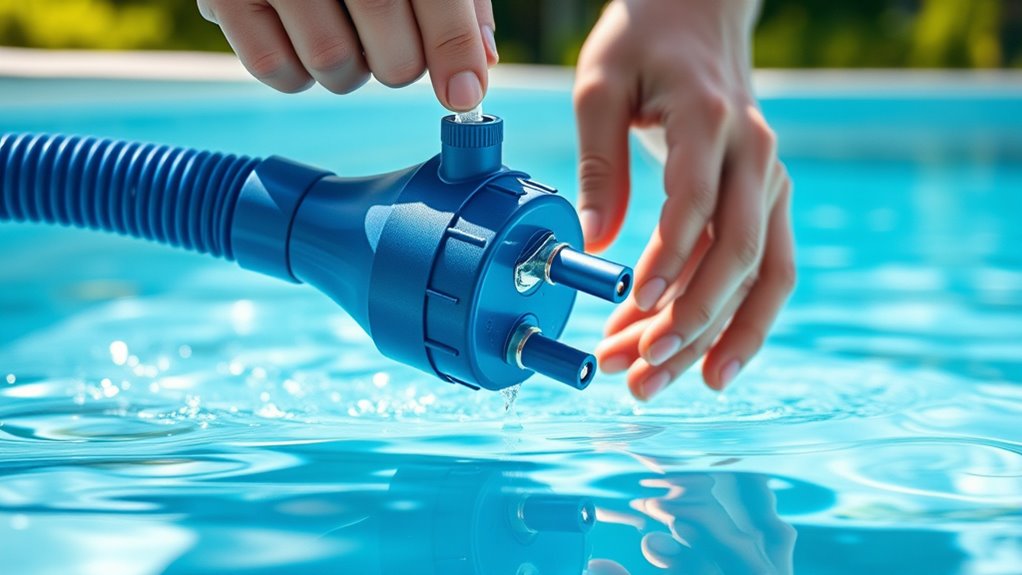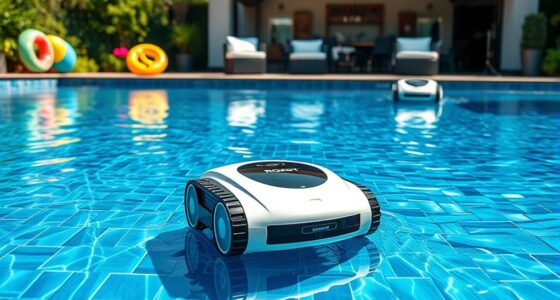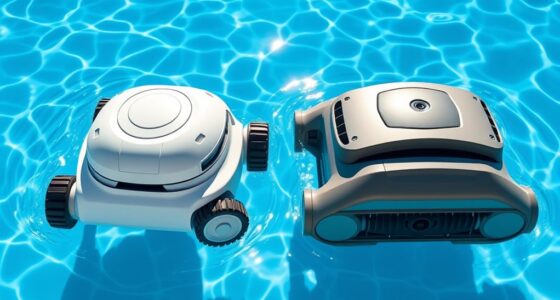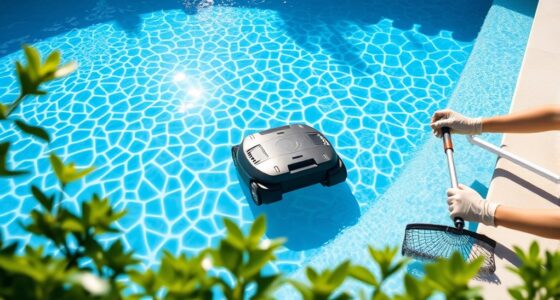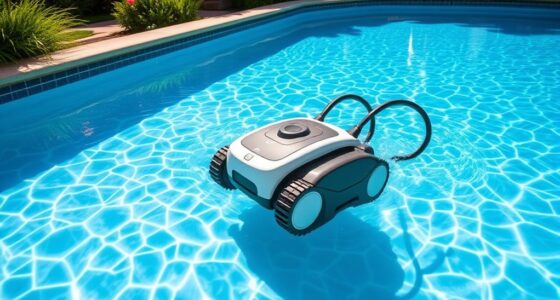If your pressure pool cleaner isn’t working well, start by checking water flow and pressure; clean or replace clogged filters and make certain the pump runs smoothly. Inspect hoses for leaks or cracks, and verify connections are tight. Clear out nozzles and jets of debris or buildup. Also, confirm the skimmer basket and water level are proper. Keep everything in good shape, and you’ll find more tips to fix common issues if you continue exploring.
Key Takeaways
- Check and clean or replace the filter cartridge to prevent flow restrictions.
- Inspect hoses and fittings for leaks, cracks, or blockages to maintain proper pressure.
- Ensure the pump operates smoothly and delivers adequate water pressure.
- Examine jets and nozzles for clogs or damage, cleaning or replacing as needed.
- Verify skimmer water level and basket condition to ensure optimal water flow and suction.
Checking the Water Flow and Pressure
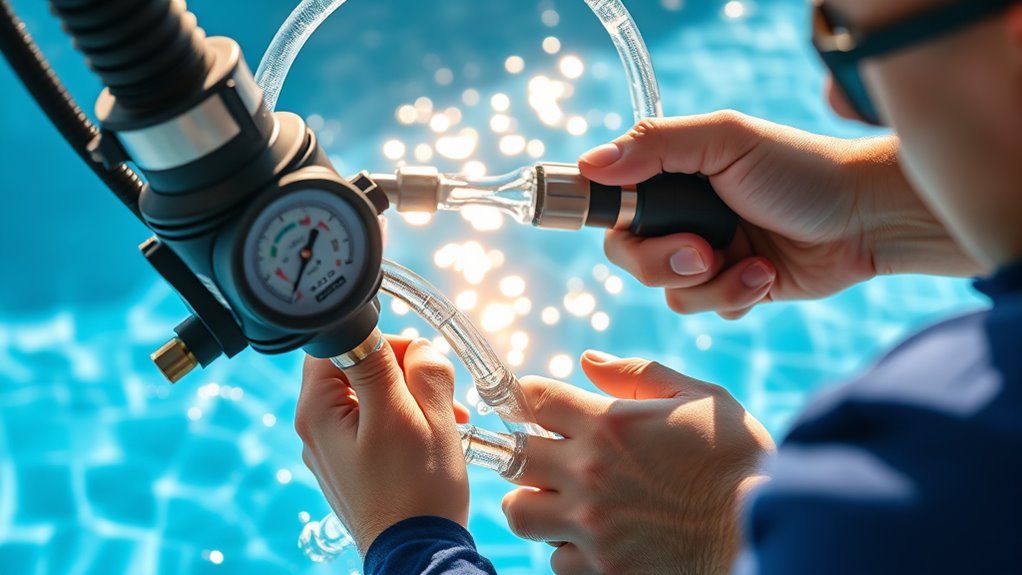
To guarantee your pressure pool cleaner operates effectively, start by checking the water flow and pressure. First, examine the filter cartridge; a clogged filter restricts water flow, reducing cleaning efficiency. Remove and clean or replace the cartridge if it’s dirty. Next, assess the pump operation; ensure the pump is running smoothly and delivering adequate pressure. A weak or inconsistent pump affects the cleaner’s performance. Verify that there are no obstructions in the skimmer or pump basket, which can hinder water flow. Also, check for any leaks or cracks around connections that could cause pressure drops. Maintaining proper water flow and pressure is vital for ideal cleaner operation, so address any issues promptly to keep your pool spotless.
Inspecting and Cleaning the Hose and Connections
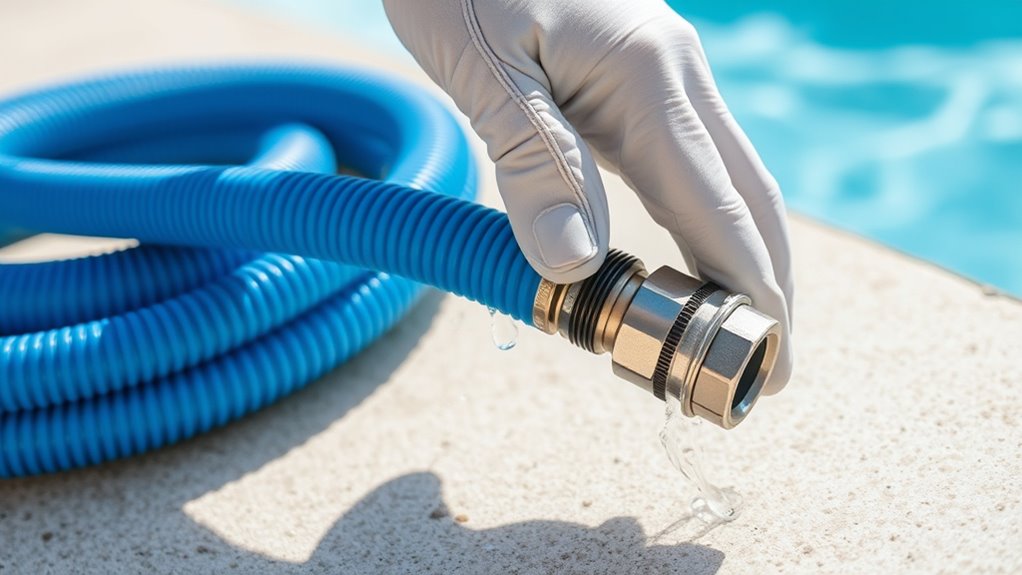
Since hoses and connections are essential for your pressure pool cleaner’s performance, regularly inspecting and cleaning them can prevent issues. Check the hose for any hose leaks, which can reduce pressure and cleaning efficiency. If you notice leaks, replace or repair the damaged section promptly. Examine the connection fittings to ensure they’re secure and free of debris or buildup. Loose or dirty fittings can cause water loss or pressure drops. Clean any dirt or algae from the fittings to maintain a tight seal. Also, inspect the hose for cracks, tears, or blockages that could hinder water flow. Properly maintaining your hoses and connections guarantees maximum pressure and prevents breakdowns, keeping your pool cleaner working smoothly. Additionally, understanding the importance of proper maintenance can help you avoid costly repairs and extend the lifespan of your equipment. Regularly checking hose integrity and cleaning fittings supports optimal system performance and efficiency. Maintaining jet propulsion systems can also enhance the overall effectiveness of your pool cleaner, especially when combined with appropriate system calibration techniques.
Examining and Clearing the Jets and Nozzles
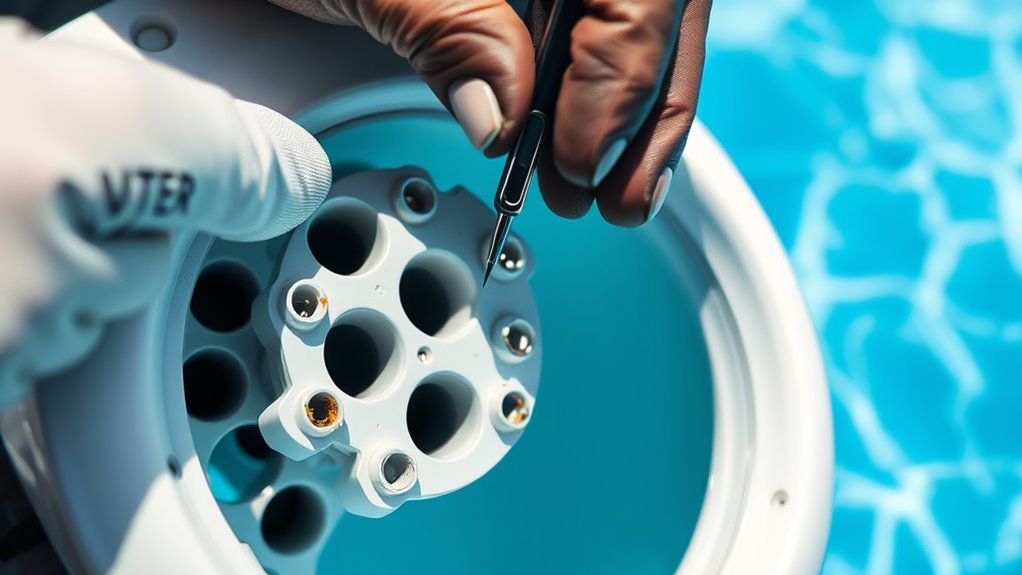
Regularly examining and clearing the jets and nozzles guarantees your pressure pool cleaner maintains ideal water flow and cleaning power. Jet blockage is a common issue that reduces efficiency, so inspect each jet carefully. If you notice water isn’t spraying properly or flow seems weak, remove the nozzles for cleaning. During nozzle maintenance, use a small brush or pin to clear any debris or mineral buildup that may be obstructing water flow. Ensure nozzles are free of cracks or damage, replacing them if necessary. Keeping jets and nozzles clean and unobstructed helps prevent pressure loss and keeps your cleaner operating smoothly. Regular maintenance of these components ensures consistent cleaning performance and extends the lifespan of your pressure pool cleaner. Additionally, inspecting for proper water filtration can help prevent buildup and ensure optimal operation. Staying aware of machine learning advancements can also inspire more efficient maintenance techniques for your equipment. Moreover, utilizing automated diagnostic tools can help identify jet blockages quickly and accurately, saving time and effort. Performing routine visual inspections can further ensure all components are functioning correctly and prevent unexpected failures. Incorporating cleaning schedules based on your pool usage can further maintain optimal jet performance.
Assessing the Pool’s Skimmer and Water Levels

Checking the pool’s skimmer and water levels is essential to guarantee your pressure cleaner operates efficiently. If the skimmer basket is full, it restricts water flow, reducing cleaning effectiveness. Here’s what to do:
- Inspect the skimmer basket—empty it if debris is blocking water flow.
- Check the water level—it should be about halfway up the skimmer opening for proper circulation.
- Adjust the water level if needed—add or remove water to reach the ideal level, ensuring the pressure cleaner functions correctly.
- Regularly monitor water quality to prevent buildup of debris and maintain optimal operation. Proper water levels help maintain consistent water circulation, which is vital for effective cleaning. Additionally, ensuring the skimmer basket is free of debris enhances overall pool maintenance.
- Keep an eye on filter system performance, as it directly impacts water flow and cleaning efficiency. Consistently inspecting and maintaining the pool’s filtration system can prevent issues that hinder pressure cleaner performance.
Maintaining a clean skimmer basket prevents blockages, while proper water levels promote maximum pressure and suction. Regularly evaluating these aspects helps keep your pressure pool cleaner working smoothly and efficiently.
Replacing or Repairing Faulty Parts

When your pressure pool cleaner isn’t working properly, replacing or repairing faulty parts is often necessary to restore its performance. Start by inspecting the pump, as pump maintenance is key to proper operation. Check for leaks, clogs, or damaged hoses that could hinder water flow. If the pressure seems low or inconsistent, it might be time to troubleshoot the motor. Motor troubleshooting involves testing electrical connections, cleaning any debris, and inspecting the motor for signs of wear or damage. Replacing worn-out parts, such as seals or impellers, can notably improve efficiency. Incorporating diagnostic tools or online resources can help identify issues more effectively. Regular maintenance and timely replacement of faulty parts ensure your pressure pool cleaner runs smoothly and effectively keeps your pool clean. Additionally, understanding sound vibrations can assist in diagnosing unusual noises or operational irregularities. Being aware of maintenance schedules can prevent future breakdowns and extend the lifespan of your equipment.
Frequently Asked Questions
How Often Should I Perform Maintenance on My Pool Cleaner?
You should follow a regular maintenance schedule to keep your pool cleaner running smoothly. Typically, you’ll want to check and clean the filter and brushes weekly, especially if you use the cleaner frequently. Adjust your cleaning frequency based on pool usage and debris levels. Regular inspections help prevent issues and ensure peak performance. By sticking to a consistent maintenance schedule, you’ll extend your cleaner’s lifespan and enjoy a cleaner, clearer pool.
Can I Use Chemical Treatments While the Cleaner Is Operational?
You can use chemical treatments while your pressure pool cleaner is operational, but you should consider chemical compatibility to prevent damage. Always follow your cleaning schedule and add chemicals when the cleaner is off or after a thorough circulation period. This ensures the chemicals don’t harm the equipment or reduce cleaning efficiency. Regularly check manufacturer guidelines for specific chemical compatibility to keep your pool cleaner functioning properly.
What Safety Precautions Should I Take During Troubleshooting?
Think of safety precautions as your shield in a battlefield. When troubleshooting, you should prioritize electrical safety by unplugging the cleaner and avoiding water contact with electrical parts. Handle chemicals carefully, wearing gloves and goggles, and avoid mixing substances. Always work in a well-ventilated area, and never attempt repairs with power connected. These steps protect you from electrical hazards and chemical exposure, ensuring a safe troubleshooting process.
Are There Eco-Friendly Alternatives to Traditional Pool Cleaners?
If you’re looking for eco-friendly pool cleaning options, consider solar-powered alternatives that use renewable energy, reducing your carbon footprint. You can also opt for biodegradable cleaning agents, which break down naturally and are safer for the environment. These options help keep your pool clean while minimizing environmental impact, making them a great choice for eco-conscious homeowners. Switching to solar-powered devices and biodegradable products is a smart, sustainable move for your pool care routine.
How Do I Reset the Pressure Pool Cleaner After Fixing Issues?
Think of resetting your pressure pool cleaner as tuning a musical instrument. First, verify the hose connection check is solid, no leaks or kinks. Then, perform a pressure sensor calibration by turning off the cleaner, waiting a few seconds, and turning it back on. This resets the system, allowing it to operate smoothly again. Your cleaner will be singing in harmony with your pool in no time!
Conclusion
Now that you’ve tackled the clues, your pressure pool cleaner should glide smoothly like a well-oiled dance partner across the water’s surface. Think of it as giving your pool a breath of fresh vitality, clearing away the stubborn grime and static. With each fix, you’re tuning up a faithful servant, transforming your pool into a sparkling oasis. Keep this troubleshooting rhythm, and your cleaner will always be ready to chase away dirt like a swift, determined breeze.
